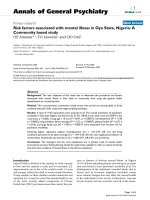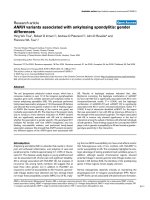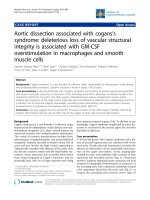Báo cáo y học: "Cardiogenic shock associated with loco-regional anesthesia rescued with left ventricular assist device implantation" docx
Bạn đang xem bản rút gọn của tài liệu. Xem và tải ngay bản đầy đủ của tài liệu tại đây (462 KB, 3 trang )
CAS E REP O R T Open Access
Cardiogenic shock associated with loco-regional
anesthesia rescued with left ventricular assist
device implantation
Louis E Samuels
1*
, Elena Casanova-Ghosh
1
, Christopher Droogan
2
Abstract
A healthy 53 year old man developed profound cardiogenic shock following instillation of bupivacaine-lidocaine-
epinephrine solution as a locoregional anesthetic for elective outpatient shoulder surgery. Intubation, resuscitation,
and transfer to the nearby hospital were done: echocardiography showed profound biventricular dysfunction; car-
diac catheterization showed normal coronary arteries. Despite placement of an intra-aortic balloon pump and intra-
venous vasoactive drugs, the patient remained in shock. Stabilization was achieved with emergent institution of
cardiopulmonary bypass and placement of a temporary left ventricular assist device (LVAD). Twenty-four hours
later, cardiac function normalized and the LVAD was removed. The patient was discharged five days later and
remained with normal heart function in three-year follow-up.
Introduction
Interscalene nerve blockade for shoulder surgery is a
common practice among anesthesiologists and orthope-
dic surgeons [1]. Although major complications are
uncommon, the most l ife-threatening ones are cardio-
toxic in nature [2]. Depending upon which agents are
utilized, the effects may be transient and rapidly resolve
or prolonged a nd require advanced resuscitative mea-
sures [3]. The case of a 53 year old man who developed
acute cardiogenic shock during administration of a loco-
regional anesthetic for outpatient elective shoulder sur-
gery is presented. Emergent institution of cardiopulmon-
ary bypass and placement of a temporary left ventricular
assist device (LVAD) were necessary as a rescue therapy
and bridge to myocardial recovery.
Clinical Summary
A 53 year old healthy man presented with should er pain
for outpatient elective arthroscopic surgery. The past
medical and surgical histories were hypertension, pan-
cre atitis, gastro-esophageal reflux disease, Lyme disease,
and appendectomy. He was a former smoker and drank
alcoholic beverages at social occasions. His medications
included omeprazole and pantoprazole; he was not aller-
gic to drugs or other products.
At the outpatient surgical center, the patient was
placed in the sitting position and prepared for applica-
tion of an interscalene nerve block. Routine monitoring
included three-lead electrocardiogr aphy, pulse oximetry,
and a blood pressure cuff. The baseline vital signs were
the following: Normothermia, BP 129/75 mmHg, PR 61
bpm, and RR 16. A solution of 0.5% Marcai ne (Hospira,
Inc., Lake Forest, IL) and 1.5% lidocaine with epinephr-
ine (1:200,000) was instilled using a standard technique.
Shortly after the instillation, the patient became tachy-
cardic and hypertensive; beta-blockade was given with
intravenous labetal ol. The patient became hypotensive
and demonstrated signs of pulmonary congestion. Intu-
bation was performed and vasoactive drugs were given
including norepinephrine and epinephrine. The cardiac
rhythm appeared to be ventricular tachycardia which
then degenerated into ventricular fibrillation requiring
cardiopulmonary resuscitation and electrical defibrilla-
tion–advanced cardiac life support (ACLS). The patient
was transferred to the nearby hospital where echocar-
diography showed severe global dysfu nction. Emergent
cardiac catheterization showed normal coronary anat-
omy; an intra-aortic balloon pump was placed; high-
dose dopamine was added to the norepinephrine infu-
sion without improvement in the shock state. Cardiac
* Correspondence:
1
Department of Cardiothoracic Surgery, Lankenau Hospital, Wynnewood, PA,
USA
Full list of author information is available at the end of the article
Samuels et al. Journal of Cardiothoracic Surgery 2010, 5:126
/>© 2010 Samuels et al; licensee BioMed Central Ltd. This is an Open Access article distributed under the terms of the Creative C ommons
Attribution License ( which permits unrestricted use, distribution, and reproduction in
any medium, provided the original work is properly cited.
surgery was consulted and the patient transported to the
operating room in extremis condition.
Cardiopulmonary bypass was rapidly instituted follow-
ing a median sternotomy. The heart appeared markedly
distended with severe biventricula r failure. An Abio med
AB5000™ (Abiomed Inc., Danvers, MA) left ventricular
assist device (LVAD) was placed (Figure 1). Restoration
of hemodynamics was immediately observed with subse-
quent reduction in the vasoactive infusions. The heart,
however, remained severely dysfunctional. The sternum
was left open in order to avoid compression of the
unsupported right ventricle–aVAC™ (Kinetic Concepts,
Inc., San Antonio, TX) dressing was applied to protect
the LVAD cannulae and provide a sterile barrier to the
mediastinum. The patient was transferred to a quatern-
ary care center for further management.
The following day, preparation was made for sternal
closure. In the operating room, the VAC ™ dressing was
removed and the heart inspected. The gross findings
confirmed the TEE assessment– biventri cular function
was restored to normal. The LVAD was weaned suc-
cessfully and remove d. Sternal closure was also accom-
plished. The remainder of the hospitalization was
unremarkable; the patient was discharged on the sixth
postoperative day. No further cardiac episodes have
occurred in three years follow-up.
Discussion
Although historically a safe and effective means of
anesthesia [4], cardi ovascular toxicity from loco-regional
anasthetics has been known for over three decades [5].
Rarely, though, is it necessary to institute extreme forms
of cardiopulmonary resuscitation, such as cardiopulmon-
ary bypass [6]. However, advanced resuscitation with
various agents, intubatio n, and occasionally defibrillation
for arrhythmia have been described [7-10].
The use of a ventricular assist device (VAD) for car-
diogenic shock is well known and a variety of condi-
tions–both medical and surgical– have warranted their
use [11]. The general criteria for their implantation are
persistent hemodynamic instability despite maximal
pharmac ological measures, often including the use of an
IABP [12]. The types of VADs vary depending upon
whether they are used as (a) a temporary u nit with
eventual removal following myocardial recovery,(b) a
long-ter m unit with the goal of removal upon successful
cardiac transplantation, or (c) a permanent unit in cases
of Destination Therapy (DT). In this case and others,
the VADs most commonly used in the setting of acute
cardiogenic shock are extra- or paracorporeal devices–
the intent being short-term (i.e. days to weeks) support
with eventual removal upon myocardial recovery. The
Abiomed AB5000™ left VAD (LVAD) is a paracorporeal
unit with an inflow attachment from the left atrium or
left ventricle and an outflow graft to the ascending
aorta. There is a right VAD (RVAD) counterpart with
inflow from the right atrium or right ventricle and out-
flow to the main pulmonary artery (Figure 2). In either
case, the VAD bloodpump is connected to a fully auto-
mated console and can deliver up to 7 liters per minute
of blood flow in a pulsatile form. The AB5000™ is FDA-
approved and available worldwide, residing in both
transplant and non-tr ansplant centers. Among the
advantages of the AB5000™ is its versatility: it can be
used as a right sided or left sided VAD and can provide
days, weeks, or months of support. As such, it can sus-
tain the circulation for short or intermediate stages of
native heart recovery or serve as a (off-label) bridge-to-
transplant device. In this particular case, short-term
application was all that was needed.
The circumstances of this case are profound and not
completely understood. For example, the usual
Figure 1 Abiomed AB5000 VAD™.
Figure 2 Abiomed AB5000 RVAD™.
Samuels et al. Journal of Cardiothoracic Surgery 2010, 5:126
/>Page 2 of 3
cardiovascular toxiciti es of loco-regional anesthesia with
bupivicaine are bradyarrhythmia and hypotension. In
this case, the initial reaction was tachycardia and hyper-
tension, suggesting a possible systemic reaction to the
epinephrine with inadv ertent intravascular administra-
tion. The subsequent events, however , were equally con-
fusing– beta-blocker use followed by ventricular
fibrillation, hypotension, and pulmonary edema requir-
ing ACLS. The cardiac dysfunction was global and p er-
sistent and was not a structural problem such as occult
coronary arteri al, valvular, or congenital disease. Rather,
it appeared to be a profoun d chemica l reaction that was
not immediately reversible. In previously reported cases
of local anesthetic induced cardiovascular collapse, the
successful use of an intravenous lipid infusion has been
described [9,10]. However, these c linical reports pre-
sume a bupivacaine based toxicity, which may or may
not have been the case reported here.
Although the exact etiology and mechanism of the
cardiogenic shock may not be elucidated, the treatment
is noteworthy. As previously mentioned, the role of
VADs is in the setting of refractory cardiac failure and
advanced mechanical support devices have salvaged
medical and surgical conditions in an ever increasing
number of scenarios. The use of the Abiomed AB5000™
was simply based on its availability. Other devices would
certainly have been considered, including an extra-cor-
poreal membrane circuit with an oxygenator (ECMO) or
the newly FDA-approv ed micro-axial flow Impella™
(Abiomed, Inc., Danvers, MA) pump (Figure 3). The
Impella ™ pump would have been an attractive device in
this case report since it can be placed either percuta-
neously or by direct femoral artery cutdown in the case
of the 2.5 L/min or 5.0 L/min versions respectively.
However, this device was not available or FDA-approved
at that time.
In summar y, the use of a VAD in the settin g of a
loco-regional anesthesia induced profound cardioge nic
shock should be considered. Rapid transfer from an out-
patient setting to a facility equipped with som e form of
advanced mechanical circulatory support device can
translate into lives saved.
Author details
1
Department of Cardiothoracic Surgery, Lankenau Hospital, Wynnewood, PA,
USA.
2
Department of Medicine, Division of Cardiology, Lankenau Hospital,
Wynnewood, PA, USA.
Authors’ contributions
LES, EC, and CD were responsible for the preparation and accuracy of the
manuscript. All authors read and approved the final manuscript.
Competing interests
LES discloses a financial relationship with Abiomed, Inc., serving as a speaker
and consultant. EC and CD have no competing interests.
Received: 28 June 2010 Accepted: 8 December 2010
Published: 8 December 2010
References
1. Long TR, Wass CT, Burkle CM: Perioperative interscalene blockade: an
overview of its history and current clinical use. J Clin anesth 2002,
14:546-56.
2. Marx GF: Cardiotoxicity of local anesthetics–the plot thickens.
Anesthesiology 1984, 60:3-5.
3. Braque S, Bernard-Bertrand F, Guillou N, et al: Successful but prolonged
resuscitation after local anesthetic induced cardiac arrest: is clonidine
effective? Acta Anaesth Belg 2008, 59:91-94.
4. Tetzlaff JE, Yoon HJ, Brems J: Interscalene brachial plexus block for
shoulder surgery. Reg Anesth 1996, 21:166-7.
5. Albright GA: Cardiac arrest following regional anesthesia with etidocaine
or bupivacaine. Anesthesiology 1979, 51:285-7.
6. Soltesz EG, van Pelt F, Byrne JG: Emergent cardiopulmonary bypass for
bupivacaine cardiotoxicity. J Cardiothorac Vasc Anesth 2003, 17:357-8.
7. Reinikainen M, Hedman A, Pelkonen O, et al: Cardiac arrest after
interscalene brachial plexus block with ropivacaine and lidocaine. Acta
Anaesthesiol Scand 2003, 47:904-6.
8. Levsky ME, Miller MA: Cardiovascular collapse from low dose bupivacaine.
Can J Pharmacol 2005, e240-e245.
9. Warren JA, Thomas RB, Georgescu A, et al: Intravenous lipid infusion in
the successful resuscitation of local anesthetic-induced cardiovascular
collapse after supraclavicular brachial plexus block. Anesth Analg 2008,
106:1578-80.
10. Rosenblatt MA, Abel M, Fischer GW, et al: Successful use of a 20% lipid
emulsion to resuscitate a patient after a presumed bupivacaine-related
cardiac arrest. Anesthesiology 2006, 105:217-18.
11. Samuels LE, Darze ES: Management of acute cardiogenic shock. Cardiol
Clin 2003, 21:43-49.
12. Samuels LE, Kaufman MS, Morris RJ, et al: Pharmacologic criteria for
ventricular assist device insertion: experience with the Abiomed BVS
5000 system. J Card Surg 1999, 14:288-293.
doi:10.1186/1749-8090-5-126
Cite this article as: Samuels et al.: Cardiogenic shock associated with
loco-regional anesthesia rescued with left ventricular assist device
implantation. Journal of Cardiothoracic Surgery 2010 5:126.
Figure 3 Abiomed Impella™.
Samuels et al. Journal of Cardiothoracic Surgery 2010, 5:126
/>Page 3 of 3









